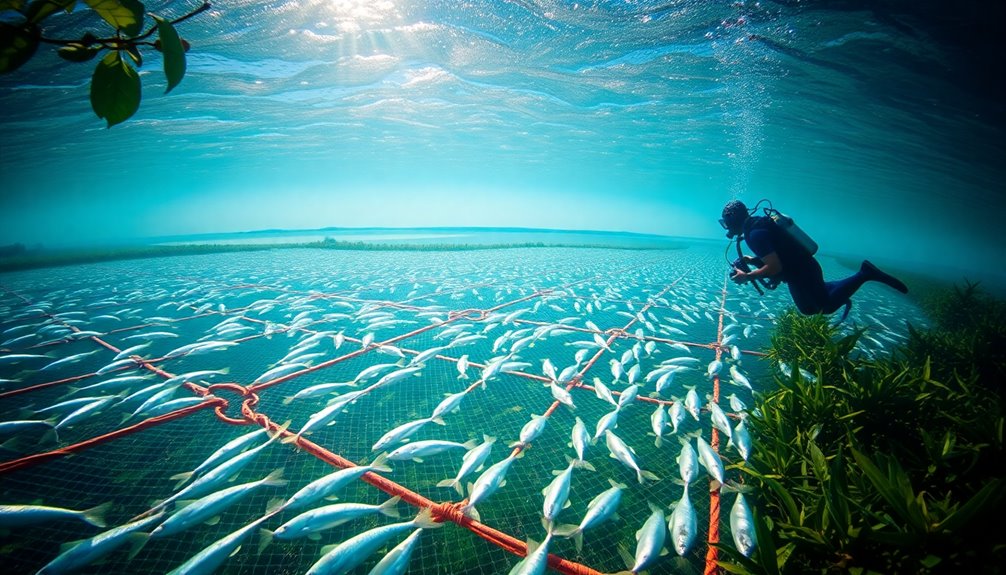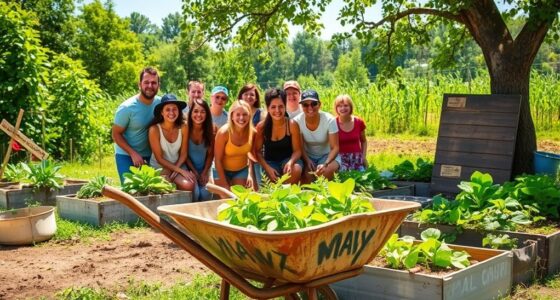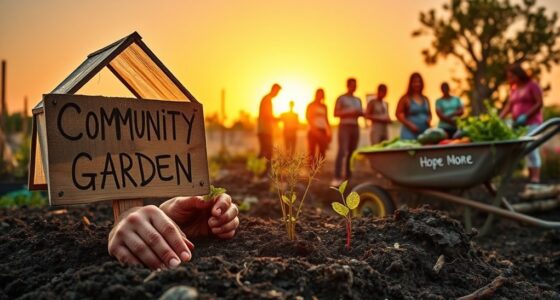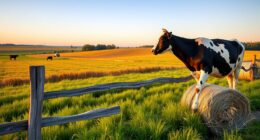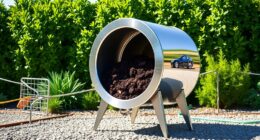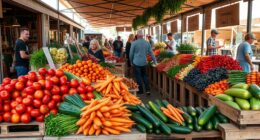Fish farming, or aquaculture, is the practice of breeding and raising fish in controlled environments to guarantee a sustainable seafood supply. You'll find that around 600 species are farmed globally, including popular ones like salmon and tilapia. This method alleviates pressure on wild fish stocks and supports food security, especially as the global population grows. While it offers numerous benefits, such as nutritious protein sources, responsible management is essential to prevent environmental issues. As technology drives innovation in fish farming, there's a lot more to uncover about its current practices and future potential.
Key Takeaways
- Fish farming, or aquaculture, involves cultivating fish and other aquatic species for food, providing over half of the seafood consumed globally.
- Various methods include cage culture, freshwater farming, brackish water farming, and Recirculating Aquaculture Systems (RAS) for improved sustainability.
- Aquaculture is vital for meeting the protein needs of a growing global population projected to reach 9.8 billion by 2050.
- The sector alleviates pressure on wild fish stocks and addresses overfishing, promoting sustainable seafood production practices.
- Technological advancements, like automated feeding and data analytics, are enhancing operational efficiency and environmental sustainability in fish farming.
Overview of Fish Farming
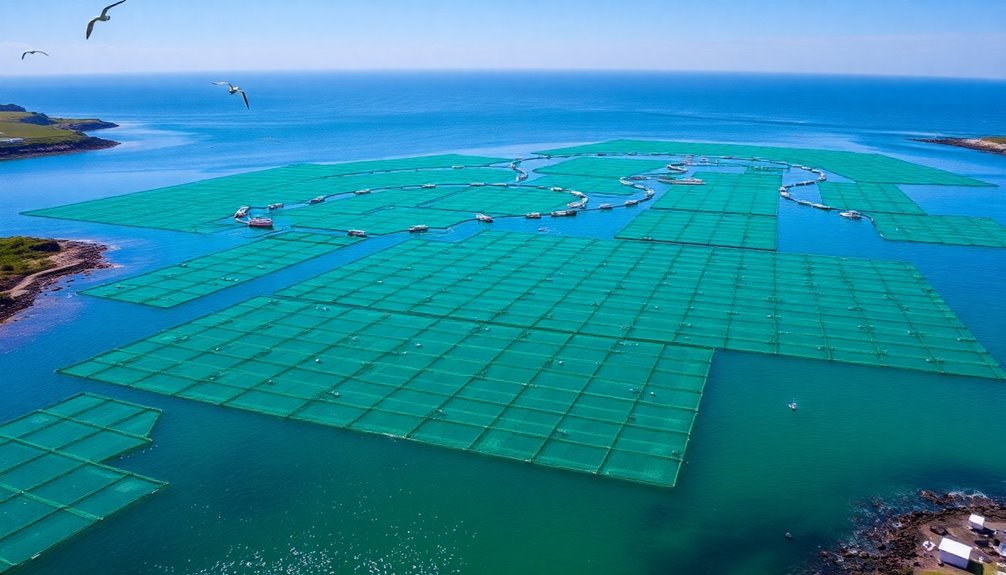
Fish farming, which has rapidly evolved over recent decades, plays an essential role in global seafood production. As a crucial component of aquaculture, it involves raising fish in controlled environments, contributing greatly to global food supply.
With around 600 species farmed worldwide, including salmon and tilapia, fish farming alleviates pressure on wild fish stocks, ensuring sustainable seafood for growing populations. This sector, the fastest-growing in food production, is projected to reach $245 billion by 2027, driven by demand for nutritious protein sources.
Types of Aquaculture
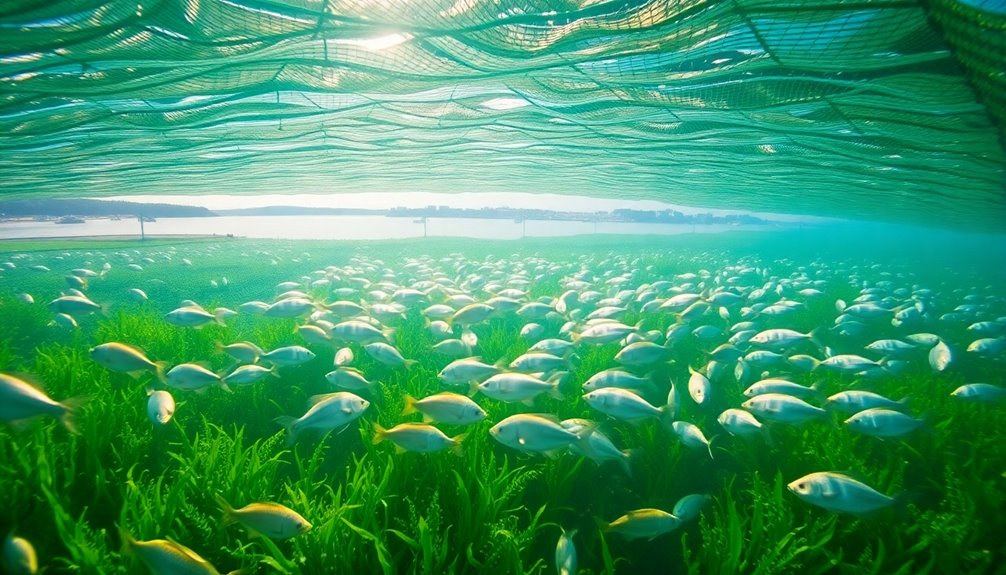
Aquaculture includes a variety of farming methods that cater to different species and environments. You'll find fish farms using techniques like cage culture, which employs submerged net pens to raise fish such as salmon and trout. Freshwater farming often involves ponds for species like trout, while brackish water is popular for shrimp. Recirculating Aquaculture Systems (RAS) utilize closed systems to improve water quality and efficiency. Integrated Multi-Trophic Aquaculture (IMTA) is another innovative approach that cultivates multiple species together, enhancing resource use.
| Farming Method | Species Typically Raised | Key Benefits |
|---|---|---|
| Cage Culture | Salmon, Trout | Efficient space usage |
| Recirculating Aquaculture | Shrimp, Tilapia | Water efficiency |
| Integrated Multi-Trophic | Various | Improved water quality |
Importance of Aquaculture
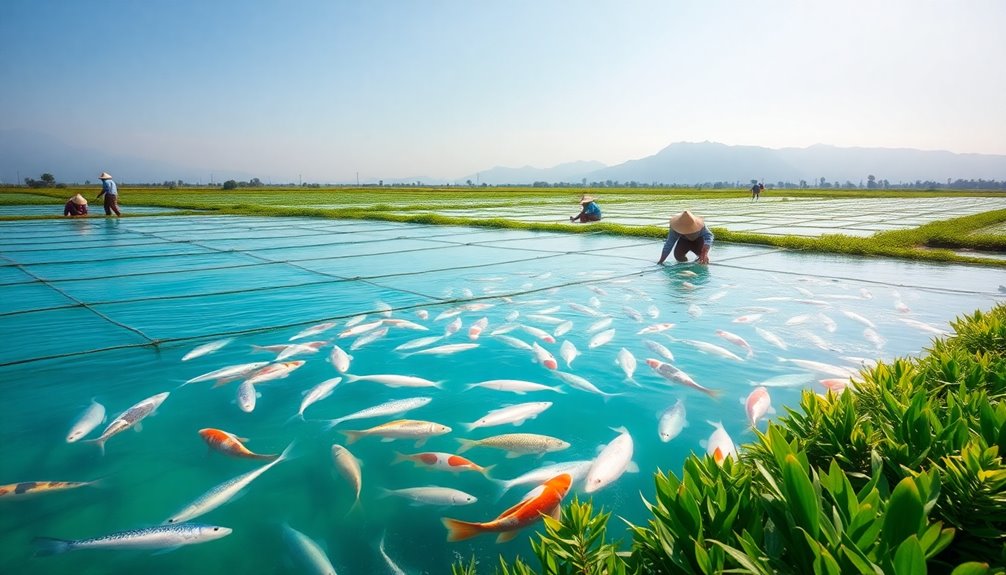
With various farming methods outlined, understanding the importance of aquaculture reveals its significant role in global food systems.
As the global population is projected to reach 9.8 billion by 2050, aquaculture serves as a fundamental source of climate-friendly protein, providing over half of the fish consumed worldwide.
By alleviating pressure on wild fish populations, it helps stabilize seafood prices and guarantees food security.
Aquaculture promotes sustainable food production with a lower carbon footprint than traditional livestock, making it indispensable in combating climate change.
Additionally, the projected $245 billion global aquaculture market by 2027 emphasizes its economic significance.
Responsible practices also enhance environmental sustainability and improve local economies, particularly in developing regions, making aquaculture essential for a sustainable future.
Benefits and Challenges
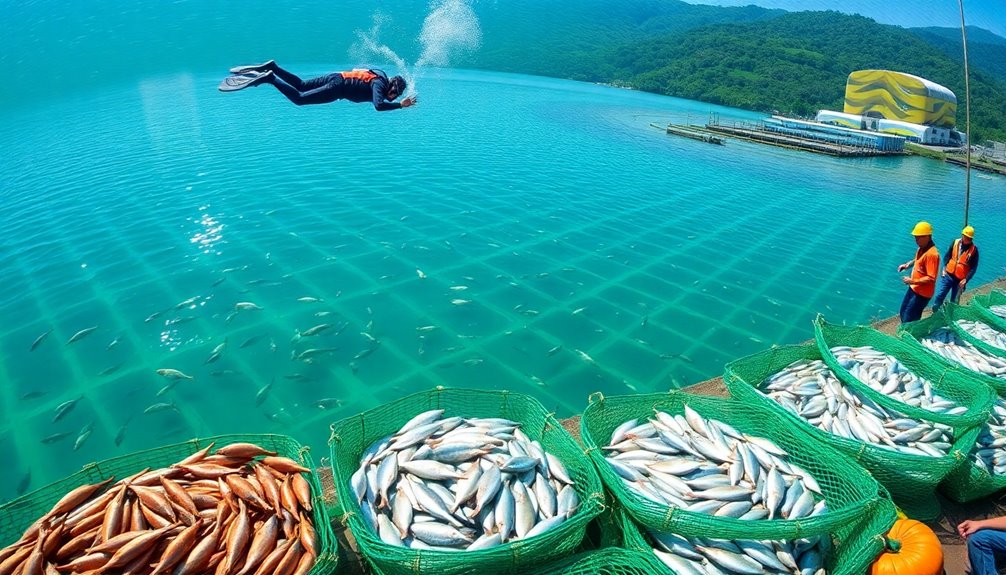
The benefits of aquaculture are vast, providing an essential source of protein and supporting economies worldwide. As the global population approaches 9.8 billion by 2050, aquaculture will play an important role in meeting rising seafood demand while alleviating pressure on wild fish stocks, which are already stressed by overfishing.
However, challenges persist. Intensive fish farming can lead to water pollution and environmental damage, making responsible management necessary to minimize negative impacts.
To guarantee sustainable practices, the ASC certification promotes responsible fish farming, supporting food security while protecting local environments.
Additionally, improving welfare standards for aquatic animals is significant. Advocacy and education are important for addressing these challenges, making sure that aquaculture develops sustainably and ethically.
The Role of ASC
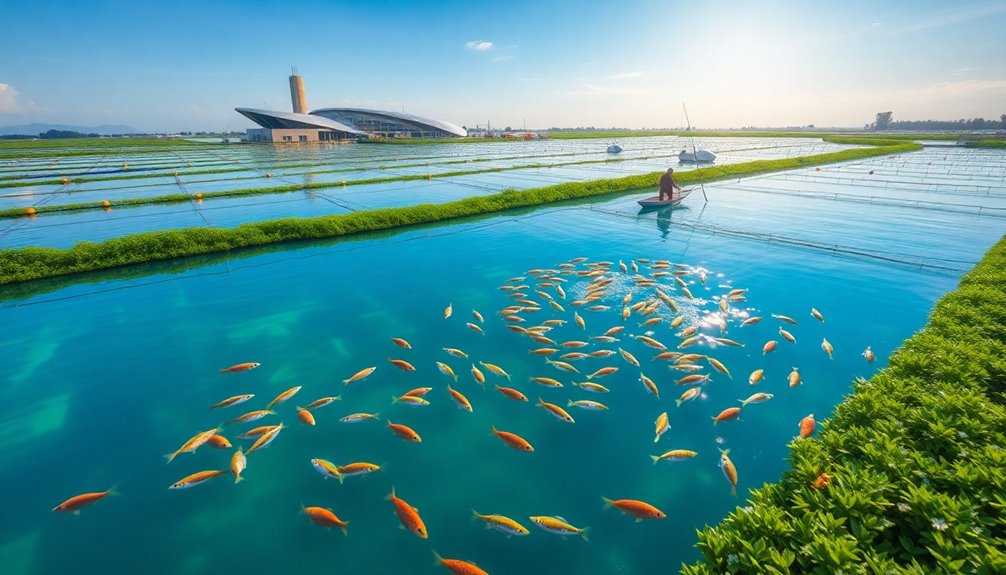
In today's seafood market, the Aquaculture Stewardship Council (ASC) plays an essential role in promoting sustainable practices that protect both the environment and local communities.
By choosing seafood products with the ASC logo, you support responsible aquaculture that emphasizes:
- Environmental protection: Ensuring that fish farming operations minimize their impact on local ecosystems.
- Rigorous certification: Farms undergo strict assessments to meet ASC's sustainability standards.
- Economic growth: Supporting livelihoods of seafood farmers, particularly in developing regions.
- Consumer trust: Over 1,000 certified farms enhance confidence in the quality of responsibly farmed seafood.
With ASC certification, you actively contribute to a healthier ocean and a more sustainable future for aquaculture.
Your choices matter in fostering environmental sustainability and economic growth in the seafood industry.
Future of Aquaculture
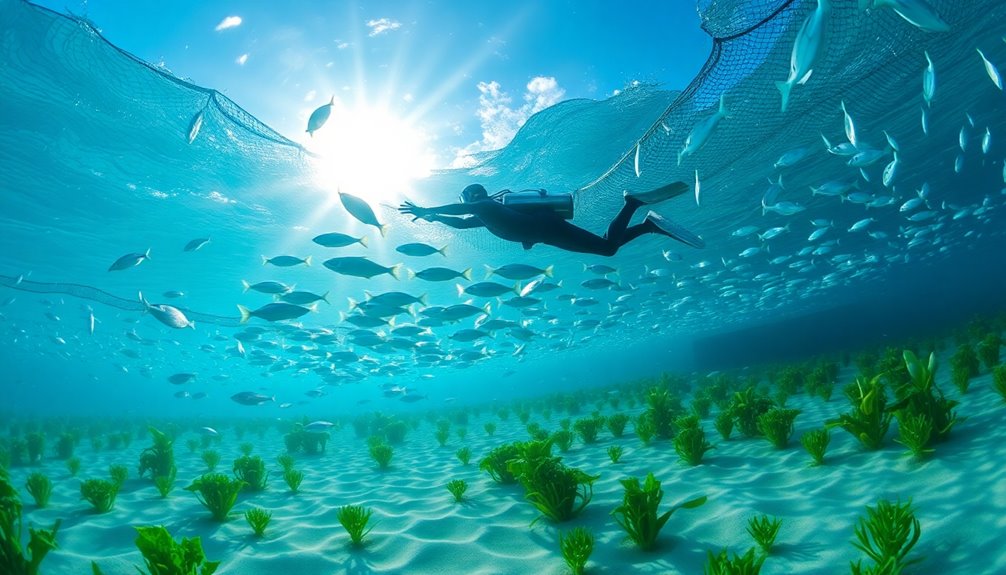
As you look ahead, it's clear that technological innovations will reshape aquaculture in exciting ways.
You'll see sustainable practices evolve, making fish farming more efficient and environmentally friendly.
This progress is essential for meeting the growing demand for seafood while ensuring a healthy planet.
Technological Innovations Ahead
Aquaculture is on the brink of a technological revolution that promises to redefine how fish farming operates.
With advancements in technology, you can expect significant innovations that enhance sustainability and fish health while minimizing environmental impacts.
Here's what's on the horizon:
- Automated Feeding Systems: These optimize feed distribution, reducing waste and improving fish health.
- Recirculating Aquaculture Systems (RAS): These enhance water recycling, allowing farming in various locations.
- Data Analytics: Improved decision-making for fish health and growth will lead to more efficient operations.
- Drones and Sensors: Real-time monitoring of water quality and fish health enables proactive management.
As collaboration between farmers and tech developers grows, the future of aquaculture looks promising and vibrant.
Sustainable Practices Evolution
How will sustainable practices shape the future of fish farming? The evolution of aquaculture systems is essential as they help meet the growing global demand for food while reducing environmental impact. Innovations like Recirculating Aquaculture Systems (RAS) and renewable energy integration play a critical role in making fish farming more eco-friendly and efficient. By adopting sustainable practices, you're not just protecting wild fish stocks but also ensuring a reliable protein source for the 9.7 billion people expected by 2050.
| Innovation | Benefit |
|---|---|
| Recirculating Systems (RAS) | Water recycling, reduced waste |
| Renewable Energy | Lowers carbon footprint |
| Advanced Monitoring | Enhances efficiency |
| Collaborative Research | Promotes responsible resource use |
Frequently Asked Questions
How Is Aquaculture Bad for the Environment?
Aquaculture can harm the environment in several ways.
You might see water pollution from excess feed and waste, leading to harmful algal blooms.
If you're aware of shrimp farming, you know it often causes mangrove deforestation, disrupting local ecosystems.
Overcrowding in fish farms allows diseases to spread, threatening wild fish populations.
Plus, the use of antibiotics and chemicals can contaminate aquatic environments, impacting both aquatic life and food safety.
What Are the Pros and Cons of Aquaculture?
When you consider the pros and cons of aquaculture, you'll find it provides essential protein and supports food security while creating jobs in rural areas.
However, it also poses challenges like water pollution and sustainability issues.
You might appreciate its lower carbon footprint compared to traditional livestock, but concerns about working conditions and environmental impacts are valid.
Balancing these factors is vital for responsible seafood production and a healthier planet.
What Are the Four Different Types of Aquaculture Farms?
When you explore the diverse landscape of aquaculture, you'll discover four main types of farms that each have their unique charm.
There's pond culture, where fish like catfish and tilapia thrive in earthen ponds.
Cage culture lets species like salmon flourish in their natural waters.
Then, there's recirculating aquaculture systems (RAS), which guarantee water efficiency and quality.
Finally, integrated multi-trophic aquaculture (IMTA) embraces a harmonious approach by recycling nutrients among different species.
What Is Aquaculture or Fish Farming?
Aquaculture, or fish farming, involves cultivating fish and other aquatic organisms in controlled environments, like ponds or tanks.
You can produce various species, such as salmon and tilapia, to meet the growing global seafood demand.
This method helps alleviate pressure on wild fish populations while offering a sustainable protein source.
Additionally, fish farming typically has a lower carbon footprint than traditional livestock farming, making it a more environmentally friendly choice for food production.
Conclusion
In the ever-evolving world of aquaculture, you're not just witnessing a method of food production; you're diving into a lifeline for sustainability and global food security. As you explore this vibrant underwater domain, remember that every fish farm is a demonstration of innovation and resilience. By supporting responsible practices, like those championed by the ASC, you're helping to nurture a future where our oceans thrive and communities flourish. Together, let's cast a hopeful net for generations to come.

